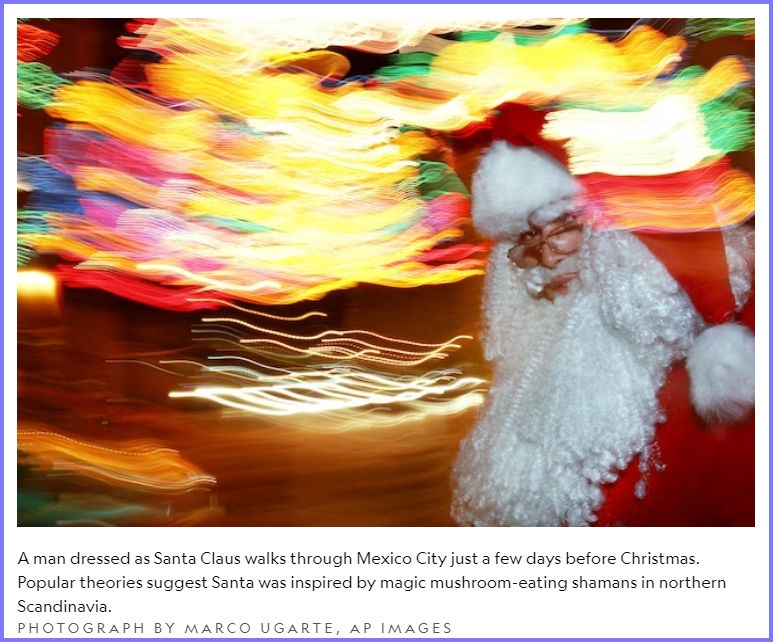The newest registered user is гераскинс
Our users have posted a total of 48009 messages in 7050 subjects

WORLD CLOCK
NAT GEO * What does Santa have to do with … psychedelic mushrooms? *
Valley of the Sun Casual Club :: WORDS , FACTS , DATES , GAMES & TRIVIA & HISTORY :: NATIONAL GEOGRAPHIC
 NAT GEO * What does Santa have to do with … psychedelic mushrooms? *
NAT GEO * What does Santa have to do with … psychedelic mushrooms? *

This Christmas theory involves a bright red and white hallucinogenic mushroom called Amanita muscaria that resembles Santa Claus's signature suit. We asked the experts if there's any merit to the colorful legend.
BYOLIVIA CAMPBELL
PUBLISHED DECEMBER 21, 2023
Where did the modern myth of Santa Claus evolve from?
One theory purports Santa is a Sámi shaman. The Sámi are the indigenous people of Sápmi (referred to as Lapland by outsiders ), in northern Scandinavia. The story goes like this: Once upon a time, Sámi shamans collected and dried Amanita muscaria—the red-with-white-spots psychedelic mushrooms commonly known as fly agaric—then on winter solstice, gave them as gifts through the openings in the ceiling of the huts in the village (since the doors were snowed shut).
Sámi are reindeer herders, so when the shamans ingested mushrooms, they imagined their reindeer flying or went on vision quests with flying reindeer as guides. In some versions of the theory, the shaman used reindeer to detoxify the fly agaric by feeding it to them and then ingesting their urine. Others posit that the reindeer were also high on ‘shrooms.
To drive the connection home, the theory notes that it was common for Sámi shamans to wear red suits, and that presents wrapped in red and white under the Christmas tree mimic mushrooms growing at the foot of evergreens.
But is there any merit to this colorful theory?
Was Santa really inspired by a Samí shaman?
“The story of Santa emerging from a Sámi shamanic tradition has a critical number of flaws,” asserts Tim Frandy, assistant professor of Nordic Studies at the University of British Columbia and a member of the Sámi descendent community in North America. “The theory has been widely criticized by Sámi people as a stereotypical and problematic romanticized misreading of actual Sámi culture.”
To see if the theory held water, Frandy looked to the history of Sámi midwinter traditions. Juovllat, or Yule, was a time to hide from the terrifying stállu, a creature who sucked out the life spirit of the Sámi with an iron tube. Since the stállu were most active during Christmastime, Sámi traditions involved precautionary measures, such as ensuring everyone—including children—stayed absolutely silent, neatly stacking wood piles to prevent snagging a stállu on errant branches, and setting out water for stállu to drink instead of blood.
“These customs weren’t exactly joyful or fun,” Frandy observes. “Sámi people, and the entirety of the Nordic north, had traditions very different from Santa. This is a major red flag suggesting that something is wrong with this theory.”
Happily, by the 1950s, the Nordic tradition of Jultomten, the gnome-like Christmas elf, largely replaced stállu among the Sámi.
Frandy goes on to debunk other elements of this theory, item by item: Fly agaric was used in much of Siberia as a mind-altering drug, but there’s scant evidence that Sámi noaiddit (shamans) used it in their rituals; rather, they were known to induce ecstatic trances using music, alcohol, or pain. While Siberian shamans’ clothing is occasionally associated with mushrooms, Sámi is not. Little is actually known about Sámi shamanic regalia since few related archeological sites survived intact.
“While it’s possible, even likely, that Sámi people formerly used amanita, it’s unlikely that this had any meaningful impact on Christmas lore in Europe,” says Frandy. The only time Frandy has seen Sámi shaman in particular connected to amanita was when a Finnish ethnographer claimed in the 1940s that Inari Sámi noaiddit used to consume amanita with seven spots.
“Growing up Finnish, Swedish, and Sámi, I’ve never heard of any mushroom associations with Christmas … until Ikea started selling mushroom decorations for Christmas trees,” Frandy muses. “In Sápmi, those mushrooms emerge in September, and by December are long gone under snow.”
What actually inspired the story of Santa Claus?
Christmas, like most Christian holidays, was a substitute for pagan festivities traditionally held around the same time. To celebrate the winter solstice, Ancient Romans threw a feast honoring children, while Norse celebrated Yule by dressing up in creepy costumes and going from house to house with gifts.
One clear Santa influence is the Dutch Sinterklaas, who remotely keeps tabs on children’s behavior and then rides his white horse across the rooftops, leaving gifts for them in their wooden shoes. Sinterklaas is largely based on Nikolaos of Myra, or St. Nicholas, a Greek bishop in the early Christian church known for his generosity and protection of children.
According to Maria Kennedy, co-director of the New Jersey Folk Festival and assistant professor in American Studies at Rutgers University, “the transformation of the Christian Saint Nicholas to a folkloric elf involves a complex interplay of many Christian and pagan customs surrounding midwinter, from the Roman Empire to the Nordic countries, and then to America and beyond.”
Santa Claus as we know him—someone who delivers toys to children’s homes by flying a sled driven by reindeer—emerged in America in 1822 with the publication of Clement Clarke Moore’s poem, An Account of a Visit from St. Nicholas (commonly known by its first line, “Twas the night before Christmas”). Illustrator Thomas Nast’s regular depictions of Santa in Harper's Magazine beginning in 1863 added his North Pole abode, elf assistants, and toy making. Nast also drew Santa as a large jolly man instead of a small jolly elf.
Frandy says Finnish and Swedish use of Sámi-inspired dress in Christmas lore has inadvertently connected the Sámi people with Santa’s image. For instance, the artist who created the iconic Coca-Cola Santa in 1931, Haddon Sundblom, was of Finnish and Swedish descent. His illustration had “Sámi-inspired aspects, including a pointed hat, bright red colors, and the heavily trimmed tunic with a wide belt, vaguely reminiscent of Sámi gákti,” Frandy explains.
That, and the use of Sámi-led reindeer pulling Santa in Christmas parades in cities across America in the 1920s, is likely where the Sámi-Santa association ends.
A lack of evidence to support these elements of the theory hasn’t stopped it from spreading. It’s been covered in many mainstream media outlets, from NPR and The Guardian to The New York Times and The Atlantic.
“I’ve never heard a Sámi person suggest there is any credibility to this story. It’s a story invented by outsiders that enlists elements of Sámi culture and transforms them into something they’re not,” Frandy says.
Unfortunately, news stories largely consult the same handful of sources and don’t cite indigenous community members. “I’ve seen multiple major news outlets tell this story in recent years,” Frandy notes. “What’s most troubling is that no one has properly taken the time to consult Sámi people about the credibility of these stories
Psychedelic Santa understandably captures the imagination. Who doesn’t love a tale about how a beloved mythological children’s character isn’t actually flying around the world but instead tripping on magic mushrooms? However, since the theory was developed and perpetuated by outsiders, it becomes more insidious than simply a bit of fun conjecture.
“As a folklorist, I know people love a good story … love a convenient and captivating historical explanation for why things exist as they do today. The problem is that these stories often overshadow historical realities,” says Frandy. “Part of this story, unfortunately, also involves settlers selectively borrowing or coopting aspects of Indigenous culture as their own.”
The Sámi already protest the use of their cultural heritage by the Finnish tourism industry’s “Santa’s Village” tourist attraction on their land, so further connecting them to the Santa myth exploits their culture.
“This sort of appropriation is reminiscent of a long history of colonial misuse of Sámi intangible cultural heritage. A choice is being made to not take the time to understand what these stories mean in Sámi contexts,” Frandy says. “It’s a form of colonial extraction.”
The history of Santa’s evolution involves plenty of whimsy as it is—why steal and twist the culture of others in an attempt to make it even more fantastical?
Valley of the Sun Casual Club :: WORDS , FACTS , DATES , GAMES & TRIVIA & HISTORY :: NATIONAL GEOGRAPHIC

 Events
Events















































































» INTRO TO WORD SMARTS
» PINTEREST ICONIC COMIX
» HISTORY FACTS * Gold wasn't always the top Olympic medal *
» Word Genius Word of the day * occlude *
» JULY NATIONAL CELEBRATION DAYS JULY 26 2024
» QUIZ TREAT QUIZ *Which mammal has the most powerful bite? *
» QUIZ TREAT ANSWER PAGE
» NAT GEO * The 2024 Olympics will likely be the hottest ever *
» NAT GEO * Sharks found with cocaine in their systems *
» WISE TRIVIA QUIZ *What was the first song ever played on the radio? *
» WISE TRIVIA ANSWER PAGE
» E.S.Etaski * Sister Seekers Book 10 now available everywhere! *
» WORD DAILY Word of the Day: * literatim *
» JULY NATIONAL CELEBRATION DAYS JULY 25 2024